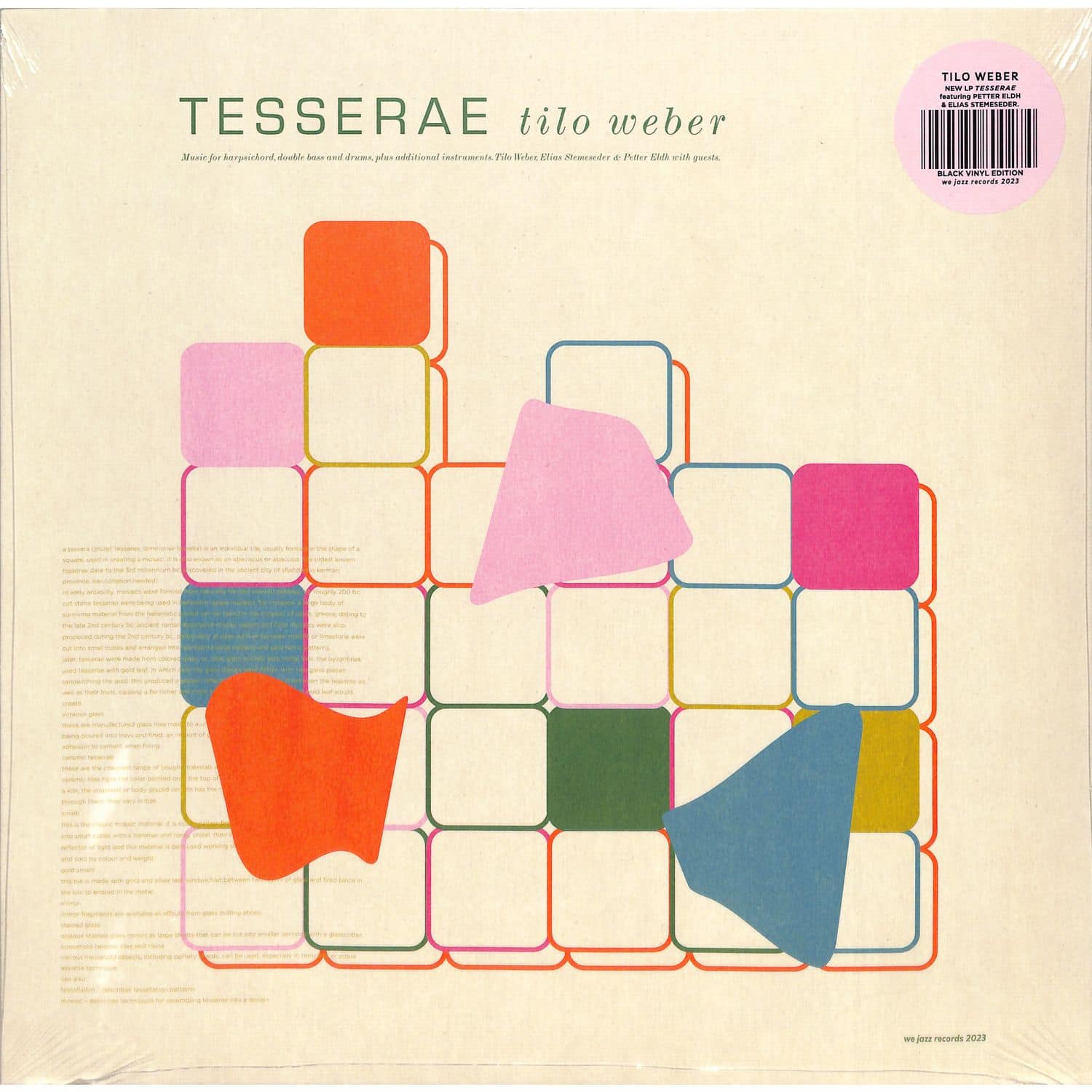Tilo Weber
TESSERAE
(FEAT. PETTER ELDH & ELIAS STEMESEDER) (LP)
12 Inch LP

Jazz, 8 track studio album
Drummer Tilo Weber joins forces with bassist Petter Eldh (Koma Saxo) and Elias Stemeseder, who plays harpsichord and keys here on Weber's We Jazz debut, "Tesserae", to be released 21 April 2023. The three musicians plus guests present a unique jazz trio sound for all times, without boundaries. Weber, based in Berlin, came to the attention of We Jazz Records with his his highly inspired drum work on Otis Sandsjö's Y-OTIS, and has since then also been awarded with the prestigious Deutscher Jazz Preis for the arrangement of the year in 2022.
"Tesserae" is the work of not only Tilo Weber the drummer, but also the visionary "full stack" artist on the rise, and the entire record consists of new, original compositions by Weber. Eldh and Stemeseder, both also part of the first incarnation of the Y-OTIS live band and the first album, are close musical partners to Weber, and the whole album brims with natural innovation and musical joy shared among the three. Each of the versatile musicians also move beyond their main instruments on the album, with Weber bringing on the vibraphone, Stemeseder tackling the celesta(!), and Eldh picking about acoustic guitar. It's easy to hear that all three are keen on going beyond what would be expected while creating this music.
The harpsichord dominates the first spin, as the very sound of the instrument sounds so delightfully alien to the modern trio setting. Indeed, "Tesserae" sounds at once baroque and futuristic. Flute, played on two tracks by Anna-Lena Schnabel and ney by Bastian Duncker on one selection, add levels that make the sound float at almost otherworldly dimensions (check "Sacre Sacre" for a case in point). The lead single "Nacre Nacre" introduces the trio in an apt way, snapping with an irresistible groove while moving not only from left to right, but also forward on a 3D spectrum of its own.
These added dimensions are there to be found for the repeated listens, suggesting "Tesserae" is an enduring album with plenty of mileage. The whole kaleidoscope of the sound reveals itself slowly, yet the impact is an instant one. Making something seemingly minimal turn out so colorful is no mean feat, and Tilo Weber & co pull it off here with remarkable ease. The album has a flow that grabs you from the first notes and builds monuments from there on.
Tilo Weber says:
"I was writing a lot of different music for various ensembles and instruments over the last 3 years. When I started this Trio I wanted it to represent a strong compositional trademark besides the improvisational impact of the players. Since Petter and Elias are both rhythmically versatile and experienced, I wanted to challenge them and collected all my musical odd-metre sketches and rhythmic patterns that I found interesting.
I have always dreamt about forming my own trio, but never really wanted to add another piano trio to the endless sea of them already out there. One day Elias told me about his harpsichord and that set this in motion. I had written some musical sketches for a trio setting, but wasn't hearing a piano playing this music. The sound of the harpsichord changed everything and inspired me to finish all tunes.
The music of this album might be the most "drummer-like" music I have written and released under my own name so far. My goal with these pieces is definitely to disrupt the conceptional composition with improvisations. Some pieces are connected to each other, because they share the same musical material. That's why they also have "related" titles. For example the bass line of 'Nacre Nacre' and 'Sacre Sacre' are the same but in different tempos. 'Sacre Sacre' is somehow a recycled version of "Nacre Nacre" and it creates a totally different atmosphere. 'Entrope Nestled' is somehow recycled from 'Time Traveler's Vessel'. The melody on the celesta is written out for the opening track of the album and lay foundation for the group improvisation in 'Entrope Nestled'. Then there are some conceptional pieces such as 'In Rapture and Rubble', that has a melody which is a transcription of the pitches made by water dripping into a cistern.
A lot of my inspiration comes from literature. I mostly read nonfiction and poems. The compositional aspect within written language fascinates me. Besides the actual meaning of the words and their power, there is always an ambiguous shadow which somehow reflects our irrational world.
The mystic nature of Rainer Maria Rilke's poems inspired me a lot. The ambiguity of his words stimulates the brain and you start reflecting your life and how you are positioned in the world. Following that tarin of thought, the track titles of the album assume the form of a poem. I asked Katie O'Riley to write a poem about mother pearl (nacre). The theme also inspired the album's title, 'Tesserae', because you mostly come across nacre when it's formed in a specific way.
When you watch nacre under the microscope you can see it's made of different layers, which almost look chaotic. That reminds me a lot of how we recorded the music of the album. We kept adding layers with synthesizers, guitar, vibraphone and additional flute and sax solos in a pretty random way and a short amount of time. I love exploring a creative process which becomes somehow irrational. Live, we always start a new process with these compositions, and that takes us into new territory each time around."[info sheet from distr.]